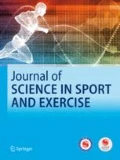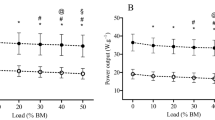Abstract
Purpose
The aim of the study was to establish the optimum variable resistance (VR) intensity for loaded countermovement jump (LCMJ) to induce post-activation potentiation (PAP).
Methods
Eleven male athletes (age 23 ± 2.3 years, height 1.77 ± 0.05 m, body mass 73.7 ± 9.0 kg) attended one familiarization and four testing sessions. Subjects performed their own pre-competition warm up before performing two countermovement jumps (CMJ) for baseline measure. Subsequently, they performed 2 × 3 unloaded (UCMJ) or loaded CMJ (LCMJ) with one of the three VR intensities, Orange (6.7 ± 0.6 kg), Red (14.0 ± 0.9 kg) and Blue (24.0 ± 1.4 kg), in random order, before performing two more CMJ for post-test measure. Each testing session was separated by at least 48 h.
Results
There was significant increase in jump height in all conditions (P < 0.05), but no significant difference in change in jump height between conditions (P > 0.05). There were small to moderate effect when comparing Orange and the other conditions. Peak force and velocity increased in Red (P < 0.05) and Orange (P < 0.05), respectively. Change in jump height was significantly correlated to change in peak velocity (r = 0.46, P = 0.002) and peak power (r = 0.46, P = 0.002).
Conclusion
The findings of the study showed that UCMJ and LCMJ were effective in improving jump height acutely, and an intensity level of about 10% body weight contributed by VR seems to be the optimum resistance level.



Similar content being viewed by others
References
Aandahl HS, Von Heimburg E, van den Tillar R. Effect of postactivation potentiation induced by elastic resistance on kinematics and performance in a roundhouse kick of trained martial arts practitioners. J Strength Cond Res. 2018;32(4):990–6.
Ashley CD, Weiss LW. Vertical jump performance and selected physiological characteristics of women. J Strength Cond Res. 1994;8(1):5–11.
Bartolomei S, Fukuda DH, Hoffman JR, Stout JR, Merni F. The influence of isometric preload on power expressed during bench press in strength-trained men. Eur J Sport Sci. 2017;17(2):195–9.
Bogdanis GC, Tsoukos A, Veligekas P, Tsolakis C, Terzis G. Effects of muscle action type with equal impulse of conditioning activity on postactivation potentiation. J Strength Cond Res. 2014;28(9):2521–8.
Burkett LN, Phillips WT, Ziuraitis J. The best warm-up for the vertical jump in college-age athletic men. J Strength Cond Res. 2005;19(3):673–6.
de Villarreal ESS, Gonzalez-Badillo JJ, Izquierdo M. Optimal warm-up stimuli of muscle activation to enhance short and long term acute jumping performance. Eur J Appl Physiol. 2007;100(4):393–401.
Dolan M, Sevene TG, Berninig J, Harris C, Climstein M, Adams KJ, DeBeliso M. Post-activation potentiation and the shot put throw. Int J Sports Sci. 2017;7(4):170–6.
Esformes JI, Bampouras TM. Effect of back squat depth on lower-body postactivation potentiation. J Strength Cond Res. 2013;27(11):2997–3000.
Faigenbaum AD, Bellucci M, Bernieri A, Bakker B, Hoorens K. Acute effects of different warm-up protocols on fitness performance in children. J Strength Cond Res. 2005;19(2):376–81.
Ferreira-Junior JB, Guttierres AP, Encarnacao IG, Lima JR, Borba DA, Freitas ED, Bottaro M. Effects of different conditioning activities on 100-m dash performance in high school track and field athletes. Percept Mot Skills. 2018;125(3):566–80.
Gullich A, Schmidtbleicher D. MVC-induced short-term potentiation of explosive force. New Stud Athletics. 1996;11(4):67–81.
Hodgson M, Doherty D, Robbins D. Post-activation potentiation underlying physiology and implications for motor performance. Sports Med. 2005;35(7):585–95.
Hopkins WG, Marshall SW, Batterham AM, Hanin J. Progressive statistics for studies in sports medicine and exercise science. Med Sci Sports Exerc. 2009;41(1):3–12.
Jaggers JR, Swank AM, Frost KL, Lee CD. The acute effects of dynamic and ballistic stretching on vertical jump height, force, and power. J Strength Cond. 2008;22(6):1844–9.
Kraska JM, Ramsey MW, Haff GG, Fethke N, Sands WA, Stone ME, Stone MH. Relationship between strength characteristics and unweighted and weighted vertical jump height. Int J Sports Physiol Perform. 2009;4(4):461–73.
Karampatsos GP, Korfiatis PG, Zaras ND, Georgiadis GV, Terzis GD. Acute effect of countermovement jumping on throwing performance in track and field athletes during competition. J Strength Cond Res. 2017;31(2):359–64.
Kümmel J, Bergmann J, Prieske O, Kramer A, Granacher U, Gruber M. Effects of conditioning hops on drop jump and sprint performance: a randomized crossover pilot study in elite athletes. BMC Sports Sci Med Rehab. 2016;8(1):1–8.
Kümmel J, Kramer A, Cronin NJ, Gruber M. Postactivation potentiation can counteract declines in force and power that occur after stretching. Med Sci Sport. 2017;27(12):1750–60.
Loturco I, Nakamura FY, Artioli GG, Kobal R, Kitamura K, Cal Abad CC, Cruz IF, Romano F, Pereira LA, Franchini E. Strength and power qualities are highly associated with punching impact in elite amateur boxers. J Strength Cond Res. 2016;30(1):109–16.
Lum D. Effects of various warm up protocol on special judo fitness test performance. J Strength Cond Res. 2019;33(2):459–65.
McMahon JJ, Suchomel TJ, Lake JP, Comfort P. Understand the key phases of the countermovement jump force-time curve. Strength Cond J. 2018;40(4):96–106.
Mina MA, Blazevich AJ, Giakas G, Kay AD. Influence of variable resistance loading on subsequent free weight maximal back squat performance. J Strength Cond Res. 2014;28(10):2988–95.
Ng CY, Chen SE, Lum D. Inducing postactivation potentiation with different modes of exercise. J Strength Cond. 2019. https://doi.org/10.1519/SSC.0000000000000522.
Sale DG. Postactivation potentiation: role in human performance. Exerc Sports Sci Rev. 2002;30(3):138–43.
Seitz LB, Haff GG. Factors modulating post-activation potentiation of jump, sprint, throw, and upper-body ballistic performances: a systematic review with meta-analysis. Sports Med. 2016;46(2):231–40.
Seitz LB, Mina MA, Haff GG. Postactivation potentiation of horizontal jump performance across multiple sets of a contrast protocol. J Strength Cond Res. 2016;30(1):2733–40.
Seitz LB, Trajano GS, Haff GG. The back squat and the power clean: elicitation of different degrees of potentiation. Int J Sports Physiol Perform. 2014;9(4):643–9.
Suchomel TJ, Sato K, DeWeese BH, Ebben WP, Stone MH. Potentiation effects of half-squats performed in a ballistic or nonballistic manner. J Strength Cond Res. 2016;30(6):1652–60.
Turner AP, Bellhouse S, Kilduff LP, Russell M. Postactivation potentiation of sprint acceleration performance using plyometric exercise. J Strength Cond Res. 2015;29(2):343–50.
Turner A, Brazier J, Bishop C, Chavda S, Cree J, Read P. Data Analysis for strength and conditioning coaches. Strength Cond J. 2015;37(1):76–83.
Wilson MJ, Duncan NM, Marin PJ, Brown LE, Loenneke JP, Wilson SMC, Jo E, Lowery RP, Ugrinowitsch C. Meta-analysis of postactivation potentiation and power: effects of conditioning activity, volume, gender, rest periods, and training status. J Strength Cond Res. 2013;27(3):854–9.
Author information
Authors and Affiliations
Corresponding author
Rights and permissions
About this article
Cite this article
Lum, D., Chen, S.E. Comparison of Loaded Countermovement Jump with Different Variable Resistance Intensities on Inducing Post-Activation Potentiation. J. of SCI. IN SPORT AND EXERCISE 2, 167–172 (2020). https://doi.org/10.1007/s42978-020-00055-4
Received:
Accepted:
Published:
Issue Date:
DOI: https://doi.org/10.1007/s42978-020-00055-4




